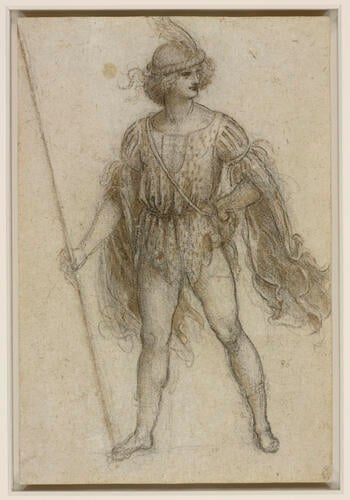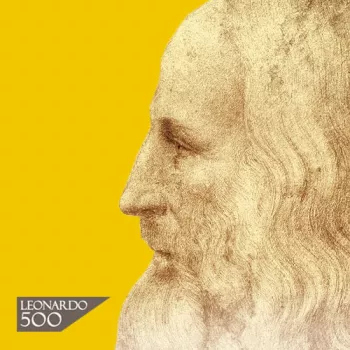A masquerader as a lansquenet c.1517-18
Black chalk, pen and ink, wash, on rough paper | 27.3 x 18.3 cm (sheet of paper) | RCIN 912575
-
A drawing of a young man, seen from the front, striding half to the left, with his head turned to the right. He wears a masquerade costume, a cap with a feather and a beribboned doublet, with flowing sleeves. His left hand is on his hip, and in his right hand he holds a lance. Melzi's number 86.
Only from the end of Leonardo’s life do we have a significant number of detailed costume drawings (RCIN 912369, 912508, 912753-912757), which give some idea of the rich dress that he must have devised on several occasions during his career, for festivals, theatrical performances and so on. Francis I had a taste for lavish entertainments, and in letters sent from the French court to Mantua we find detailed descriptions of festivities held in 1518 – in honour of the young Federico Gonzaga, then completing his education at the French court, and to celebrate the baptism of the Dauphin and the wedding of the King’s niece Madeleine de la Tour d’Auvergne to Lorenzo di Piero de’ Medici (for whom Leonardo had briefly worked three years earlier in Florence). For instance at one event Federico Gonzaga was described as:
very showy, dressed as a lansquenet, with half-boots, one completely dark, the other less dark, edged with a white and yellow riband cut in the German manner, a tunic half of satin, the edge of silver cloth, and golden cloth made into scales, with a German-style shirt worked with gold, and over this a cape of dark cloth fitted with a riband of gold and silver cloth made in the French manner.
The richness and layering of textiles described in the letters is exactly what Leonardo was aiming at in RCIN 912574–912577, with ribbons, plumes, fringes, spotted furs, and quilted sleeves and breeches. But the use of particoloured material carried a loaded meaning – striped, checked and scalloped clothing was associated with mercenary soldiers (as in the lansquenet of RCIN 912575), fools, minstrels and prostitutes; the dignified guests of Francis I were dressing up not just exotically, but in something risqué. The atmospheric handling of the black chalk in RCIN 912576, 912577 and 912508 is that of Leonardo’s last years, and the drawings are close enough in their effect of multi-layered elegance, and in many details, to suggest that they are studies for costumes to be worn at such events, and that one of Leonardo’s roles at the French court was to provide designs for the King’s seamstresses.
Text adapted from Leonardo da Vinci: A life in drawing, London, 2018Provenance
Bequeathed to Francesco Melzi; from whose heirs purchased by Pompeo Leoni, c.1582-90; Thomas Howard, 14th Earl of Arundel, by 1630; probably acquired by Charles II; Royal Collection by 1690
-
Creator(s)
Acquirer(s)
-
Medium and techniques
Black chalk, pen and ink, wash, on rough paper
Measurements
27.3 x 18.3 cm (sheet of paper)
Object type(s)
Other number(s)
RL 12575Alternative title(s)
A standing masquerader










